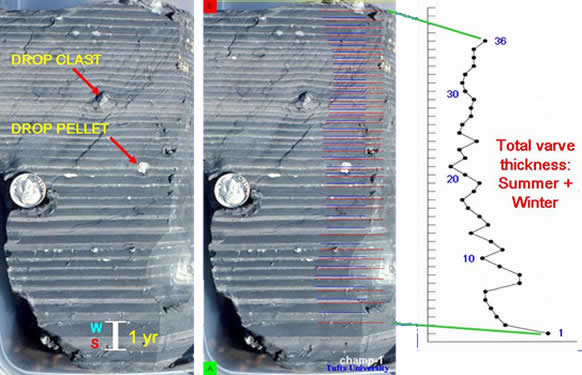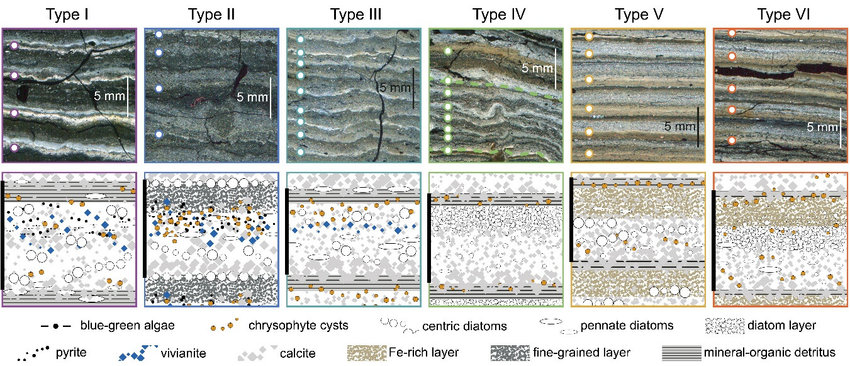What Are Varves?
Varves are thin layers of sediment that form at the bottom of lakes each year. Like tree rings, each layer represents one year of time. Scientists can count these layers to determine how many years they represent.
Two Layers = One Year
Each year creates two distinct layers:
- Light Summer Layer: When snow melts or rain increases, more sediment washes into the lake, creating a thick, light-colored layer.
- Dark Winter Layer: When the lake freezes or water flow decreases, only fine particles slowly settle, creating a thin, dark layer.
By counting pairs of light and dark layers, scientists can count individual years going back in time.

How Varves Form
Varves only form under specific conditions. Not all lakes create countable annual layers.
There must be a clear difference between summer and winter. Summer brings more sediment through snowmelt or storms. Winter brings quiet conditions with little new sediment.
The lake bottom must be undisturbed. Strong currents or animals digging in the sediment can mix up the layers. Many varved lakes have low oxygen at the bottom, which prevents animals from living there and disturbing the layers.
The lake needs enough sediment each year to create visible layers, but not so much that individual storms or events overwhelm the seasonal pattern.
Once laid down, the layers must stay intact. New sediment on top helps protect older layers from being disturbed.
Where Varves Form Best
The best places for varves are deep glacial lakes, fjords that receive glacial meltwater, and deep temperate lakes that freeze in winter.
How Scientists Count Varves
Counting varves requires careful laboratory work:
- Getting Samples: Scientists use special drilling equipment to extract long tubes of undisturbed sediment from lake bottoms. They take multiple samples to ensure they have complete records.
- Preparing Samples: Cores are carefully split open and cleaned. Sometimes they're treated with resin to make them stable for analysis.
- Counting & Measuring: Using magnification and sometimes microscopes, scientists count each layer pair. They use high-resolution cameras and chemical analysis to detect subtle differences between layers. Each layer's thickness is precisely measured.
Avoiding Mistakes
Scientists use microscopes to tell the difference between true annual layers and unusual layers caused by floods or landslides. They look for seasonal indicators like pollen types that confirm the layers represent annual cycles.

Building Longer Records
Individual sediment cores often represent only hundreds or a few thousand years. Scientists build longer chronologies by matching patterns between different cores, similar to how tree-ring scientists work.
Pattern Matching
Distinctive patterns of thick and thin varves reflect regional climate variations affecting multiple lakes. A sequence of unusually thin layers (indicating drought years) in one core should match the same pattern in nearby cores from the same time period.
Marker Layers
Special layers provide powerful anchors. For example, volcanic ash (tephra) layers from major eruptions create distinctive deposits across wide regions at the same time, helping scientists align different records.
Connecting to the Present
Some varve sequences extend right to the present day, allowing scientists to count backward year by year. Others are "floating" chronologies that scientists anchor by finding connections to historically dated events or other dating methods.
Real Examples
Several locations around the world have produced well-documented varve chronologies that extend back tens of thousands of years.
Lake Suigetsu (Japan): 50,000+ Annual Layers
- This lake contains a continuous sequence of over 50,000 individually counted annual layers. Independent radiocarbon dates on plant remains found within specific layers confirm the varve count is accurate.
- Bronk Ramsey et al. 2012, Science: A complete terrestrial radiocarbon record for 11.2–52.8 kyr BP from Lake Suigetsu.
- Kitagawa & van der Plicht 1998, Science: Atmospheric radiocarbon calibration to 45,000 yr BP using Suigetsu varves.
- Schlolaut et al. 2014, Quaternary Science Reviews: Event layers in SG06; protocols for excluding non-annual layers and synchronizing varve counts with 14C.
Cariaco Basin (Venezuela): Annual Ocean Layers
- Seasonal ocean upwelling creates annual layers in this marine basin. Varve counts provide high-resolution dating for climate studies.
- Hughen et al. 2000, Science: Synchronous radiocarbon and climate shifts during the last deglaciation.
German Lakes: Varves + Volcanic Ash
- Annual lake sediments in German volcanic lakes contain precisely dated volcanic ash layers that confirm the accuracy of varve counting.
- Brauer et al. 1999, Quaternary International: Lateglacial varve chronology and climate from Meerfelder Maar.
- Zolitschka 1998, Quaternary Science Reviews: A 14,000-year varve chronology from Lake Holzmaar.
Scandinavian & Swiss Lakes: Multiple Confirmations
- Ojala & Alenius 2005, Boreas: 10,000 years of interannual sedimentation recorded in Lake Nautajärvi (Finland).
- Lake Soppensee (Switzerland): Laminated sediments used for radiocarbon calibration with independent varve counts (series of papers in Radiocarbon, 1993–1995; e.g., Hajdas et al.).
What Varves Tell Us
Dated varve sequences provide detailed information about past conditions:
Past Climate
Thick varves often indicate wet years with heavy runoff. Thin varves suggest dry years. The sediment contains pollen and tiny fossils that reveal what plants grew nearby and what the water conditions were like.
Natural Disasters
Varves can precisely date earthquakes (through disturbed layers), floods, landslides, and volcanic eruptions. They also record the beginning of human pollution.
Testing Other Dating Methods
Because varves provide year-by-year counting, they serve as an independent check on radiocarbon dating. Studies like Lake Suigetsu and the Cariaco Basin use varve counts to calibrate radiocarbon dates.
Year-by-Year Detail
Unlike other dating methods that give approximate ages, varves can reveal what happened in individual years, providing extremely detailed records of environmental change.
Problems and Limitations
Varve chronologies have several important limitations:
Limited Geographic Range
Countable varves only form under specific conditions, so they're not available everywhere like other dating methods.
Missing or Extra Layers
Sometimes a year might not deposit a layer (drought conditions), or multiple events in one year might create what looks like several annual layers. Scientists must carefully identify and account for these situations.
Disturbance
Bottom-dwelling animals, underwater landslides, or strong currents can mix up the layers. Scientists address this by taking multiple cores and selecting the best-preserved sections.
Counting Difficulties
Sometimes layer boundaries are unclear, especially in older or disturbed sections. The uncertainty in counts typically increases with age. Scientists reduce this problem through replication and cross-dating with other records.
Young Earth Concerns
"Multiple layers could form in one year"
This is a valid concern. Scientists address it by using detailed analysis to identify and exclude non-annual layers. They look for specific features (like sharp boundaries from floods or landslides) that distinguish event layers from true annual layers. Studies document these methods carefully (e.g., Schlolaut et al. 2014).
"Catastrophic floods could create many layers quickly"
True annual varves show repeating seasonal patterns: spring diatom blooms, summer minerals, winter organic matter. They show year-to-year thickness variations that match regional climate patterns over thousands of years. These complex, repeating patterns are very different from what a single catastrophic flood would create. Multiple independent sites (Suigetsu, Cariaco, German lakes) show the same patterns and correlate with volcanic ash layers and other dating methods.
"Radiocarbon dating might be wrong"
The Lake Suigetsu study addresses this by dating terrestrial plant leaves found within individual varves—these have no marine reservoir effects or other complications. The radiocarbon ages align perfectly with the independently counted varve years (Kitagawa & van der Plicht 1998; Bronk Ramsey et al. 2012).
The Bottom Line
Even if we focus on just one site—Lake Suigetsu—scientists have documented over 50,000 individually counted annual layers with independent confirmation. This single location alone provides strong evidence for an age much greater than 6,000-10,000 years.
Bottom Line
Varve chronology provides a direct, observable method for measuring time through annual sediment layers. The evidence shows:
- Annual Formation: Each layer represents one year, confirmed by seasonal indicators.
- Direct Counting: Scientists can count individual years layer by layer.
- Cross-Checking: Multiple sites show matching patterns and correlate with other dating methods.
- Independent Confirmation: Volcanic ash layers, radiocarbon dates, and other methods confirm the counting.
Multiple independent sites preserve tens of thousands of demonstrably annual layers, providing clear evidence for an Earth much older than several thousand years.
Sources
- Bronk Ramsey, C., Staff, R.A., et al. (2012). A complete terrestrial radiocarbon record for 11.2 to 52.8 kyr BP from Lake Suigetsu, Japan. Science 338:370–374.
- Kitagawa, H., & van der Plicht, J. (1998). Atmospheric Radiocarbon Calibration to 45,000 yr B.P. Science 279:1187–1190.
- Hughen, K.A., Southon, J., Lehman, S.J., Overpeck, J.T. (2000). Synchronous radiocarbon and climate shifts during the last deglaciation. Science 290:1951–1954.
- Brauer, A., Endres, C., Negendank, J.F.W. (1999). Lateglacial varve chronology and climate from Meerfelder Maar, Germany. Quaternary International 61:17–25.
- Zolitschka, B. (1998). A 14,000-year varve chronology from Lake Holzmaar, Germany. Quaternary Science Reviews 17:1181–1196.
- Ojala, A.E.K., & Alenius, T. (2005). 10,000 years of interannual sedimentation recorded in Lake Nautajärvi (Finland). Boreas 34:133–139.
- Schlolaut, G., Marshall, M.H., Brauer, A., et al. (2014). Event layers in the Lake Suigetsu (SG06) sediment sequence: synchronizing varve counting and 14C. Quaternary Science Reviews 83:24–36.
- Zolitschka, B. (2007). Varved lake sediments. Encyclopedia of Quaternary Science, Elsevier.
See also the series of Radiocarbon papers on Lake Soppensee (1993–1995, Hajdas et al.; Bonani et al.) for independent calibration using annually laminated sediments.